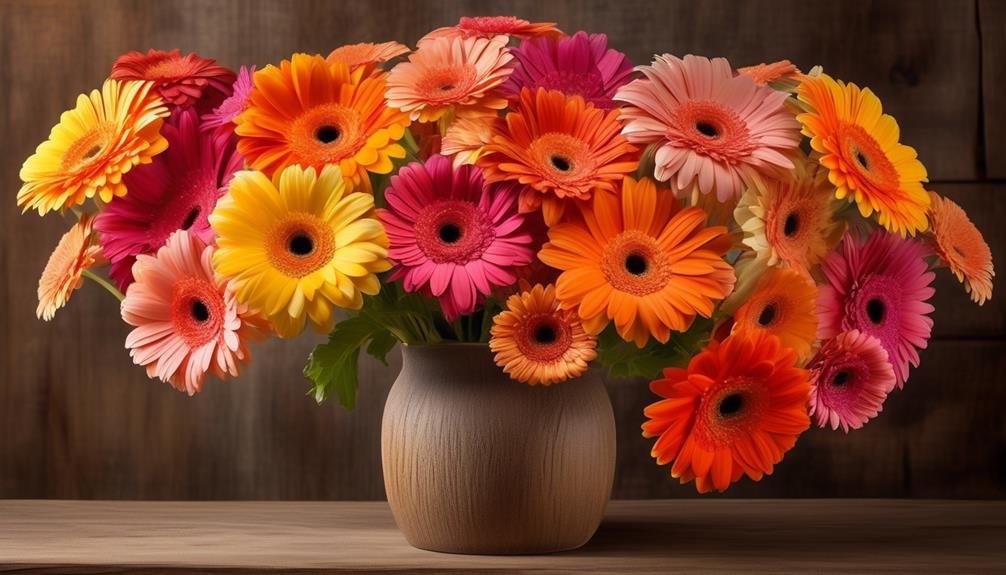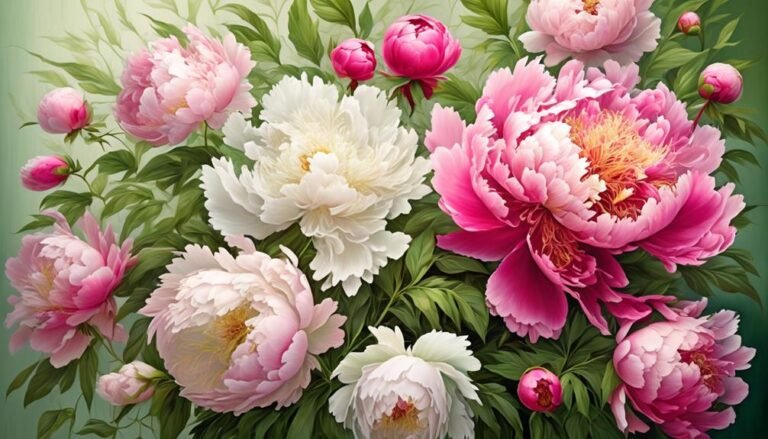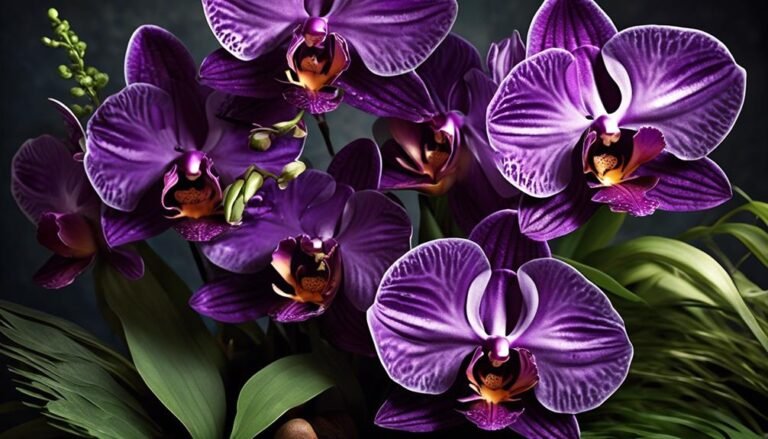Popular Types of Florist Flowers – Gerbera
Gerbera flowers are popular among florists for their vibrant colors and cheerful appearance. They are often referred to as 'the happy flower' due to their striking hues. But there's more to gerberas than just their visual appeal. These flowers have a fascinating history and an array of intriguing characteristics that make them a favorite among florists and flower enthusiasts.
Origin and History:
Gerberas are native to South Africa and were named after the German naturalist Traugott Gerber. They belong to the daisy family and are known for their large, colorful blooms. Gerberas come in a variety of shades including red, orange, yellow, pink, and white, making them versatile for floral arrangements.
Characteristics:
One of the most distinctive features of gerbera flowers is their long vase life. They can last up to 14 days after being cut, making them a popular choice for bouquets and floral displays. Gerberas also symbolize innocence, purity, and cheerfulness, making them a meaningful gift for various occasions.
Cultural Significance:
In the language of flowers, gerberas are associated with happiness and positive emotions. They are often used in celebrations and festivals to convey joy and optimism. Gerbera flowers are also used in traditional medicine for their potential anti-inflammatory and healing properties.
Floral Design and Arrangements:
Gerberas are versatile flowers that can be used in various floral designs, from wedding bouquets to table centerpieces. Their bold and vibrant petals add a pop of color to any arrangement, and their long stems make them easy to work with in different floral designs.
In conclusion, gerbera flowers are not only visually appealing but also carry cultural significance and practical benefits. Their long vase life, vibrant colors, and symbolic meanings make them a popular choice for florists and individuals looking to add a touch of happiness to their floral arrangements.
Scientific Name
Gerbera daisies, scientifically known as Gerbera jamesonii, belong to the Asteraceae family. These vibrant flowers thrive in well-drained, fertile soil with a slightly acidic to neutral pH and require ample morning sunlight while being protected from intense afternoon heat. Adequate air circulation is essential to prevent diseases, and regular watering is necessary, but waterlogging should be avoided.
Symbolism and meanings associated with Gerbera daisies vary based on their colors. Red symbolizes love, yellow represents cheerfulness, pink signifies admiration, and white denotes purity. These daisies are popular choices for weddings and joyful occasions due to their association with innocence, purity, and beauty. Additionally, they're linked to the positive energy of the sun and are known for uplifting moods with their vibrant hues.
Understanding these aspects enhances their value as ornamental plants and cut flowers, allowing for optimal growth and appreciation of their symbolic meanings in various cultural and celebratory contexts.
Background History
Gerbera daisies, named after Traugott Gerber, a German doctor and botanist in 1737, have a rich background history intertwined with cultural symbolism and horticultural significance. These vibrant and cheerful flowers have been admired by many famous personalities throughout history. Notably, the Egyptians believed that gerberas symbolized a closeness to nature and devotion to the sun, and they held these flowers in high regard.
Gerberas generally represent innocence, purity, cheerfulness, and loyal love, making them a popular choice for gifts and decorations. The introduction of gerberas to Britain in the nineteenth century further solidified their horticultural significance, as they quickly became beloved garden and cut flowers.
Throughout history, famous admirers of gerberas have extolled their vibrant colors and unique beauty. These flowers have also been used in various cultural ceremonies and traditions to symbolize joy, purity, and positivity. The rich background history of gerberas reflects their enduring popularity and significance in both horticulture and cultural symbolism.
Physical Description

Gerbera flowers are known for their captivating beauty and unique floral structure, making them a popular choice for various occasions, especially wedding bouquets. Let's explore the key physical characteristics of gerbera flowers:
- Composite Blooms: Gerbera flowers are composite blooms, consisting of ray florets, disc florets, and trans florets. This intricate structure adds to their visual appeal, making them an attractive option for creative floral arrangements.
- Hybridized Cultivars: There are over 300 hybridized cultivars of gerbera flowers, offering a wide range of options including single, double, and spider varieties. This diversity allows for the creation of distinct and personalized floral designs, perfect for special events like weddings.
- Botanical Features: Gerbera plants are recognized by their serrated leaves and hollow, fuzzy stems of varying heights. The blossom diameters can range from 2 to 6 inches, depending on the cultivar, providing flexibility in creating stunning and personalized floral arrangements.
With their vibrant colors and intricate composite structure, gerbera flowers are indeed a captivating botanical specimen, perfect for adding a touch of natural beauty to any special occasion.
Colours and Characteristics
Gerbera flowers come in a diverse array of captivating colors and have deep symbolic meanings. The range of colors is extensive, spanning from bright and fiery shades like burnt orange and shocking pink, to soft pastel tones such as pale pink and light purple. Different color gerberas represent different sentiments, with bright colors symbolizing cheerfulness and energy, pastel tones conveying innocence and purity, and dark colors adding a dramatic and rich touch to floral arrangements.
Gerberas are known for their long vase life of around 7-10 days, making them popular for floral displays and arrangements. Their vibrant colors and sturdy stems make them ideal for various floral compositions. Whether used in cheerful and energetic displays with bright hues, or in delicate and innocent settings with pastel tones, gerberas are versatile and popular in a wide range of floral arrangements.
Varieties Available
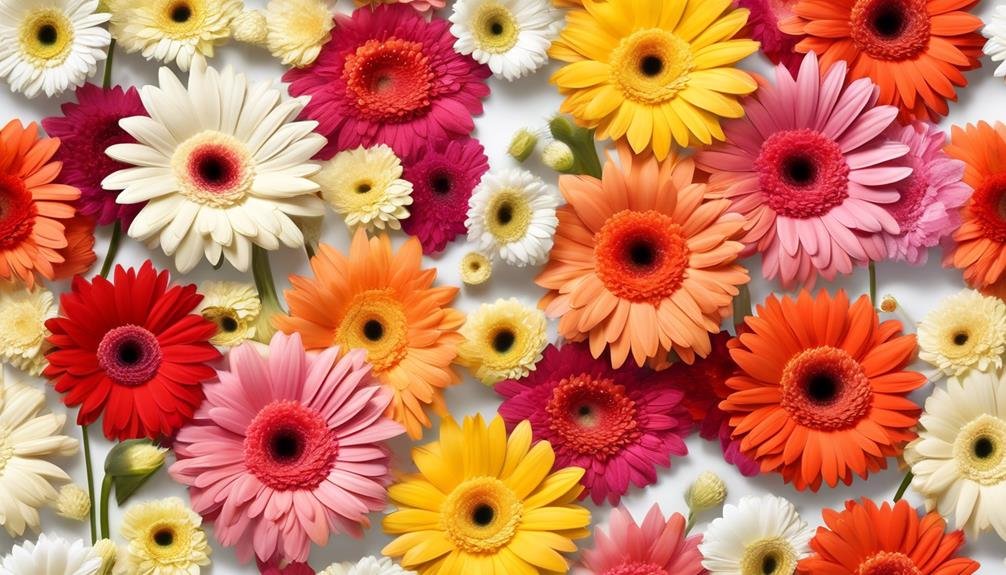
Gerbera daisies come in over 200 varieties, offering a wide range of colors and sizes for floral arrangements.
- Hardy Gerbera Garvinea
The hardy gerbera garvinea is known for its resilience and ability to withstand various weather conditions, making it perfect for outdoor displays. The Garvinea series includes vibrant reds, sunny yellows, and rich oranges.
- Mini Gerbera (Germini)
Mini gerbera, also known as germini, is a smaller version of the standard gerbera daisy, ideal for boutonnieres, corsages, and petite bouquets. Despite its smaller size, it comes in an impressive range of colors, making it versatile for florists.
- Mega Revolution Series
The Mega Revolution series offers diverse varieties of pot-growing gerberas, including 'White with Light Eye', 'Orange with Light Eye', and 'Deep Rose with Light Eye'. These compact gerberas are popular for indoor spaces or small gardens, with striking colors and unique eye patterns.
These different gerbera varieties cater to a wide range of uses, from outdoor landscaping to indoor floral displays, contributing to their popularity in floral arrangements.
Seasonal Availability
Gerbera daisies are available year-round thanks to greenhouse cultivation. However, the spring and summer months offer the most diverse selection of colors and varieties. Fall and winter still provide access to gerberas, though with a slightly more limited range. Specialty varieties and colors may be more prominent during certain seasons, so consulting with florists for seasonal preferences can be beneficial.
Despite seasonal variations, gerberas are suitable for various occasions throughout the year, including celebrations, weddings, and decorations. Their vibrant hues make them an excellent choice for birthdays, anniversaries, and corporate events. Gerberas' long stems and large, colorful blooms also make them ideal for visually striking bouquets and centerpieces.
Care Tips
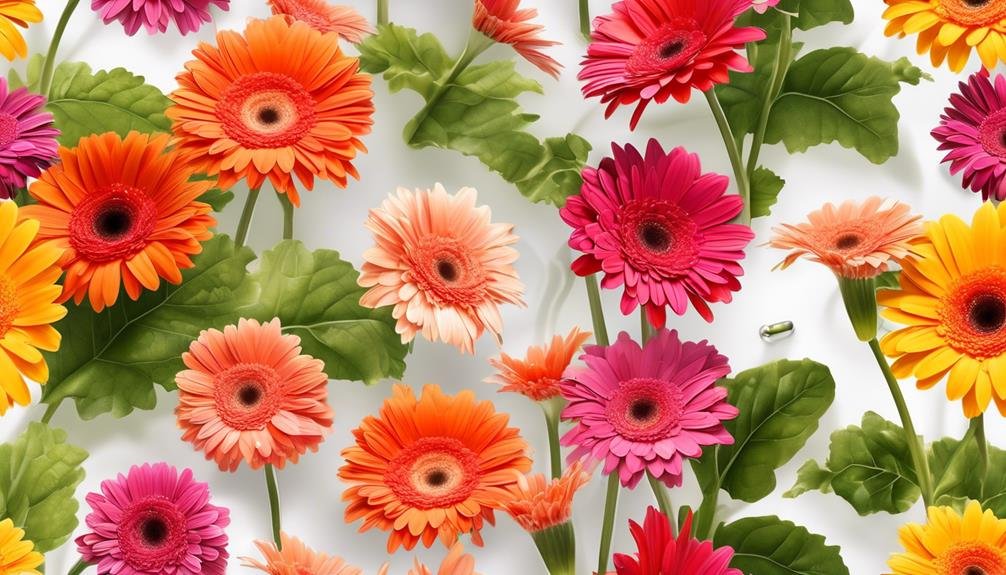
Gerbera flowers can last longer with proper care and maintenance. Here are some tips to help you maximize their vase life:
- Hydration: Clean the vase thoroughly and cut the stems at an angle before placing the gerberas in fresh, shallow water with flower food. This provides essential nutrients and hydration.
- Temperature and Environment: Keep gerberas away from heat and direct sunlight as they prefer cooler temperatures. This helps to prevent wilting and extend their vase life.
- Regular Maintenance: Replace the water every 2-3 days to prevent bacterial buildup and trim the stems at an angle with sharp, clean scissors every few days to facilitate water uptake.
When arranging gerberas, consider pairing them with complementary flowers and foliage for creative and versatile floral displays. Their vibrant colors and large, daisy-like blooms make them perfect for cheerful mixed bouquets or elegant standalone presentations.
What Makes Gerbera Flowers Popular Among Florists?
Florists adore using gerbera flowers in their arrangements due to their vibrant colors and long vase life. As one of the popular types of flowers, gerberas come in various hues, making them versatile for any occasion. Their daisy-like appearance and large blooms make them a standout choice for floral designs.
Conclusion
Gerbera daisies are a popular choice for florists and flower enthusiasts around the world. Originating from South Africa, Asia, South America, and Tasmania, these cheerful and long-lasting flowers come in over 200 varieties and a wide range of colors.
Their simplicity, purity, and year-round availability make them a top choice for adding vibrant color and beauty to any setting.
